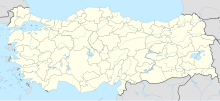Battle of Hill 60 (Gallipoli)
| Battle of Hill 60 | |||||||
|---|---|---|---|---|---|---|---|
| Part of the Gallipoli Campaign in the Middle Eastern Theatre of the First World War | |||||||
 Kaiajik Dere and Hill 60, 1919 |
|||||||
|
|||||||
| Belligerents | |||||||
|
|
|||||||
| Commanders and leaders | |||||||
|
|
|
||||||
| Strength | |||||||
| 4,000 | Unknown | ||||||
| Casualties and losses | |||||||
| 1,100 | Unknown | ||||||
|
|
|||||||
The Battle of Hill 60 was the last major assault of the Gallipoli Campaign. It was launched on 21 August 1915 to coincide with the attack on Scimitar Hill made from the Suvla front by Major-General H. de B. De Lisle's British IX Corps, Stopford having been replaced in the few days previous. Hill 60 was a low knoll at the northern end of the Sari Bair range which dominated the Suvla landing. Capturing this hill along with Scimitar Hill would have allowed the Anzac and Suvla landings to be securely linked.
Two major attacks were made by Allied forces, the first on 21 August and the second on 27 August. The first assault resulted in limited gains around the lower parts of the hill, but the Ottoman defenders managed to hold the heights even after the attack was continued by a fresh Australian battalion on 22 August. Reinforcements were committed, but nevertheless the second major assault on 27 August faired similarly, and although fighting around the summit continued over the course of three days, at the end of the battle the Ottoman forces remained in possession of the summit.
Hill 60 (Kaiajik Aghala) commanded the low ground occupied by a thin line of outposts between the Allied forces at Anzac and Suvla. The hill was to be taken as part of an attack that stretched over a two-mile front from Hill 60 through Hetman Chair, Hill 70 and Oglu Tepe. The initial attacking force was based on troops allocated to Major-General Herbert Cox by Lieutenant-General William Birdwood:
...
Wikipedia

